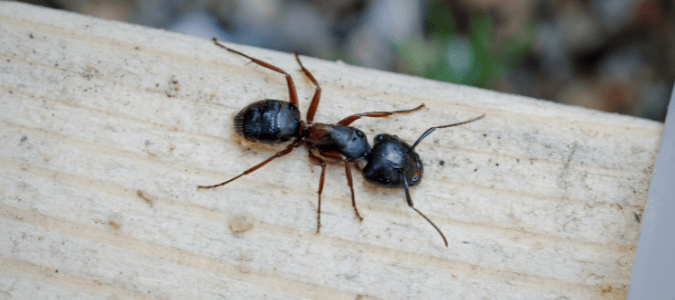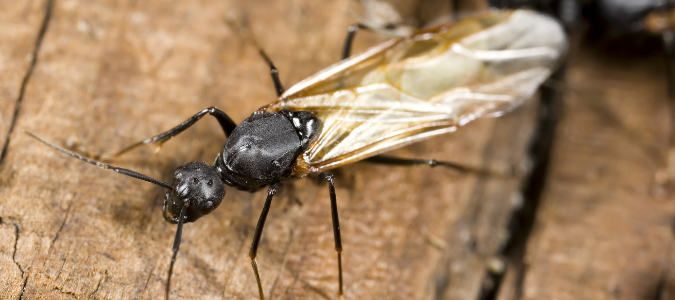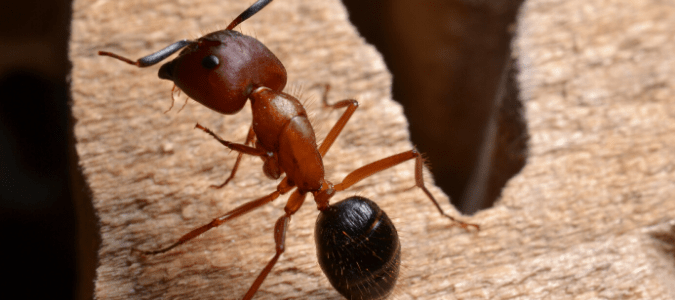Finding big black ants in your home can be shocking and scary. What exactly are they, how did they get in and what are they looking for? Most of all, how can you get rid of them, fast? Unfortunately, most big black ants found in people’s homes are carpenter ants. They’re called carpenter ants because they build their homes in wood by chewing and tunneling through it. Much like termites, if they aren’t discovered and eliminated, carpenter ants can cause a lot of hidden structural damage in a home.
Unlike termites, which also look to some people like big black ants, carpenter ants don’t actually eat wood. Rather, they use their large mandibles—their strong mouthparts that are used for chewing—to build tunnels, called galleries, by crunching up the wood. Instead of swallowing the wood, they spit it out, creating wood shavings that look a lot like loose, shredded sawdust. Along with spotting these big black ants themselves, finding piles of wood shavings near wooden areas like baseboards, window sills and door jambs is another common sign of carpenter ants in the home.
If you aren’t sure whether the insect you’ve found inside your home is a carpenter ant, a termite or something else, you can look for identifying characteristics to help you figure it out. There are two big differences between carpenter ants and termites: their size and the shape of their bodies.
Adult carpenter ants are bigger than adult termites. While termites grow to about three-eighths of an inch long, including their long wings, carpenter ants can grow to a half-inch in length, not including wings that might make them look even larger. Most carpenter ants that people see in their homes are the workers, which don’t have wings, though winged carpenter ants are also active and visible at certain times of year. Carpenter ants also have segmented bodies with very narrow “waists,” whereas termites have unsegmented bodies.
Carpenter ants are distinct from other kinds of ants, too. For one thing, they’re a lot bigger. Their heads are also somewhat heart-shaped instead of the round heads most ants have, and their heads and bodies are very dark in color. But their size is the main thing about carpenter ants that is noticeably different from other ants as well as from termites.
Carpenter ants eat the same foods most ants eat. Inside people’s homes, that usually means spilled foods or grease they find on stoves and countertops; pet food left out in bowls; or pantry foods that haven’t been stored properly, like syrup, honey or sugar. Outside in nature, these ants eat plant juices and nectars as well as other insects to survive. They can also eat insects inside your home, too.
If you find carpenter ants in your home, they may have been attracted to the food sources they can find in your kitchen. But, their presence also means something else. Carpenter ants have a hard time tunneling through dry, hard wood. It’s much easier for them to tunnel through soft, damp wood, and they build their nests within this type of wood. Outdoors, they build nests within rotting tree stumps or logs, or in wooden posts, decking or fencing that is decaying due to age and water damage. The presence of carpenter ants inside the home typically indicates some part of the home’s interior wood framing is rotting or damaged.
This is why it’s wise to have them treated if you see carpenter ants inside your house. They can cause a lot of damage if allowed to go untreated. If you’re able to find where they are nesting, you may even be able to see wood with visible tunnels and open spaces where the ants have chewed through it for their own uses.
Since it can be hard to know whether you’re dealing with carpenter ants, some other type of ants or termites, it’s a good idea to reach out to a pest control professional for an accurate identification. A professional will know exactly what type of pest has invaded your home, and will be able to tell the extent of the infestation. This information will tell them the right products and techniques to use in treating the pests. A professional can also tell the homeowner what damage has been done to their home, if any, so it can be fixed and the home’s structural integrity restored.
Do Carpenter Ants Have Wings?
If you find what looks like a very large ant with wings, you might wonder, “Do carpenter ants have wings?” Certain carpenter ants do have wings, and knowing how to identify these insects will help in figuring out if you have a pest problem. Winged carpenter ants are most active at certain times of year, which is when people are most likely to see them. Let’s take a closer look at the carpenter ant life cycle to learn more about these insect pests.
Winged carpenter ants are the swarmers—the ones responsible for mating, breeding and building new colonies. They fly out to find mates in late spring or early summer, and once they’ve mated, the winged males die. The females shed their wings and start looking for a new place, such as a crack or crevice in some wood, to build a nest and lay eggs. Female carpenter ants lay only one batch of eggs at first, and wait until those hatch and grow into worker ants before laying more.
It takes about two months for carpenter ant eggs to hatch into larvae, then pupae, and finally into adult carpenter ants. If the weather is colder than usual, or if the eggs are laid late enough in the year that winter sets in before they’ve hatched, the process can take quite a bit longer. (Carpenter ant colonies actually go dormant in wintertime.)
This is why it takes a number of years for a carpenter ant nest to grow into a full-blown colony. Two or more years into the establishment of a carpenter ant colony, the queen ant starts producing winged ants that will eventually fly off to find mates and start the mating and nesting process all over again.
In spring and early summer, people may spot swarmer carpenter ants in their homes. Anytime from spring through fall, they might see worker ants—the ones without wings. Seeing either type of carpenter ant indoors is a sign that there may be a colony nesting nearby, and merits reaching out to a pest control professional who can identify the pests, find their nest and treat them.
There are other signs of swarming carpenter ants, too, including signs that people might notice after having been away, meaning a swarm occurred while they weren’t present. If you spot small holes in wooden surfaces like baseboards or window or door frames, these could have been made by tunneling carpenter ants. Piles of what looks like wood shavings or sawdust in these same areas—by baseboards, window sills or door jambs—is another common sign of the presence of carpenter ants. You might even spot this “sawdust” coming out of holes in the wood, since the ants tunnel by chewing up the wood and then pushing it out of their nests to create open cavities inside.
That said, carpenter ant damage and termite damage can get easily confused. If you see any of these signs of carpenter ant activity, it’s time to reach out to a pest management specialist. A specialist can make an accurate identification of what you’re dealing with and determine how to treat the pests.
How to Get Rid of Carpenter Ants
If you want to get rid of carpenter ants, the best and most effective way to do it is to find and treat their nest. Unfortunately, since much of the damage these ants cause is hidden inside walls, beneath floors or in other wooden areas of people’s homes, a carpenter ant colony can be tough to find. If it’s large and established, it can be even tougher to get rid of. There are several things a homeowner can do to fight against carpenter ants, but keep in mind that treating a large colony is a job that’s best left to a professional.
Preventing carpenter ants is easier than eliminating them once they’ve moved in. Keep an eye out for water damage anywhere in or around your home, since damp, rotting wood attracts carpenter ants looking for a good place to build a nest. Repairing or replacing damaged wood in and around your home will help keep these ants away.
Sometimes, especially during a hot, dry summer, finding carpenter ants indoors doesn’t necessarily mean there’s a colony destroying your home from the inside out. Instead, it can mean the ants are looking for water and food they can’t find outside, and they found an easy way into your house. Repairing gaps around windows and doors; stuffing wire mesh into weep holes and gaps around outdoor vents or hose bibs; repairing broken screens; and replacing worn out weatherstripping on door thresholds will all go a long way toward keeping all kinds of pests out, including carpenter ants.
Since carpenter ants inside may actually be nesting somewhere outside, it’s also a good idea to clear away tree stumps, fallen logs, old firewood and any other sources of wood near the house that might harbor dampness, leading to decay. Just be careful when moving anything harboring these ants, as carpenter ants can bite. These steps will help to keep these ants far away from your home, so they won’t eventually make their way in.
A pest control professional is often your best line of defense against carpenter ants. A pro can identify these ants, find their hidden nests, and eliminate the pests so they don’t slowly but surely destroy your home.
ABC Can Treat the Carpenter Ants in and Around Your Home
Dealing with any kind of ant can be a nuisance. But, dealing with ants that can damage your home is concerning. If you’re having a carpenter ant problem, contact ABC Home & Commercial Services. Our highly trained pros will create a custom pest control solution, so you don’t have to deal with these insects.


